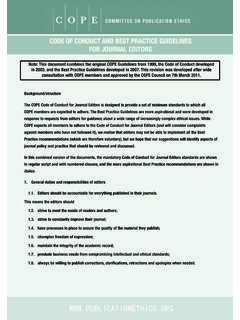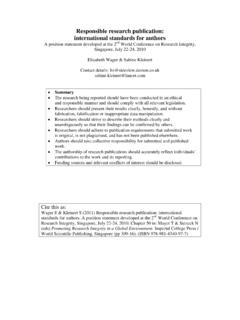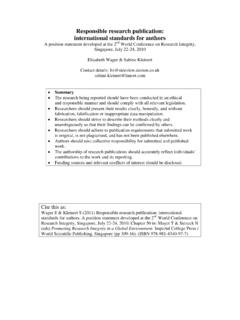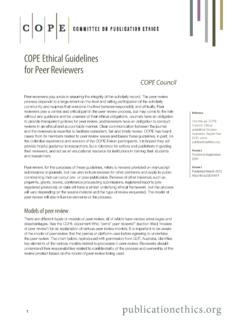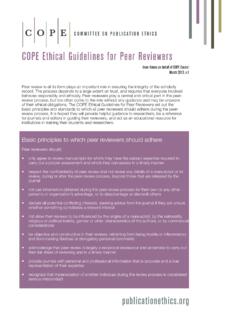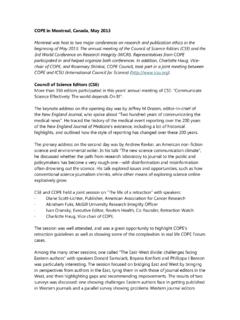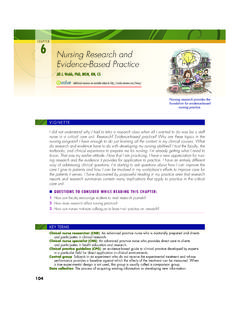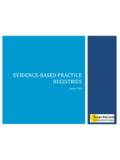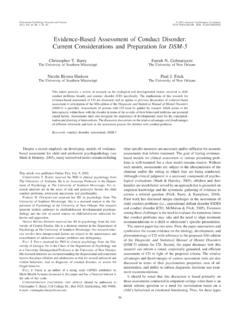Transcription of CODE OF CONDUCT AND BEST PRACTICE …
1 COPEC O MMIT T E E O N P U B LICA T I O N E T H ICSNote: This document combines the original COPE Guidelines from 1999, the code of CONDUCT developed in 2003, and the Best PRACTICE Guidelines developed in 2007. This revision was developed after wide consultation with COPE members and approved by the COPE Council on 7th March 2011. code OF CONDUCT AND BEST PRACTICE GUIDELINES FOR JOURNAL 4 Approved 7th March 2011 Published March 2011 Background/structureThe COPE code of CONDUCT for Journal Editors is designed to provide a set of minimum standards to which all COPE members are expected to adhere.
2 The Best PRACTICE Guidelines are more aspirational and were developed in response to requests from editors for guidance about a wide range of increasingly complex ethical issues. While COPE expects all members to adhere to the code of CONDUCT for Journal Editors (and will consider complaints against members who have not followed it), we realise that editors may not be able to implement all the Best PRACTICE recommendations (which are therefore voluntary), but we hope that our suggestions will identify aspects of journal policy and PRACTICE that should be reviewed and this combined version of the documents, the mandatory code of CONDUCT for Journal Editors standards are shown in regular script and with numbered clauses.
3 And the more aspirational Best PRACTICE recommendations are shown in General duties and responsibilities of Editors should be accountable for everything published in their means the editors strive to meet the needs of readers and authors; strive to constantly improve their journal; have processes in place to assure the quality of the material they publish; champion freedom of expression; maintain the integrity of the academic record; preclude business needs from compromising intellectual and ethical standards.
4 Always be willing to publish corrections, clarifications, retractions and apologies when O MMIT T E E O N P U B LICA T I O N E T H ICSCODE OF CONDUCT AND BEST PRACTICE GUIDELINES FOR JOURNAL PRACTICE for Editors would include actively seeking the views of authors, readers, reviewers and editorial board members about ways of improving their journal s processes encouraging and being aware of research into peer review and publishing and reassessing their journal s processes in the light of new findings working to persuade their publisher to provide appropriate resources, guidance from experts ( designers, lawyers)
5 Supporting initiatives designed to reduce research and publication misconduct supporting initiatives to educate researchers about publication ethics assessing the effects of their journal policies on author and reviewer behaviour and revising policies, as required, to encourage responsible behaviour and discourage misconduct ensuring that any press releases issued by their journal reflect the message of the reported article and put it into context2. Relations with Readers should be informed about who has funded research or other scholarly work and whether the funders had any role in the research and its publication and, if so, what this PRACTICE for editors would include.
6 Ensuring that all published reports and reviews of research have been reviewed by suitably qualified reviewers (including statistical review where appropriate) ensuring that non-peer-reviewed sections of their journal are clearly identified adopting processes that encourage accuracy, completeness and clarity of research reporting including technical editing and the use of appropriate guidelines and checklists ( MIAME,1 CONSORT2) considering developing a transparency policy to encourage maximum disclosure about the provenance of non-research articles3 adopting authorship or contributorship systems that promote good PRACTICE ( so that listings accurately reflect who did the work)4 and discourage misconduct ( ghost and guest authors)
7 Informing readers about steps taken to ensure that submissions from members of the journal s staff or editorial board receive an objective and unbiased evaluationCOPEC O MMIT T E E O N P U B LICA T I O N E T H ICSCODE OF CONDUCT AND BEST PRACTICE GUIDELINES FOR JOURNAL Relations with Editors decisions to accept or reject a paper for publication should be based on the paper s importance, originality and clarity, and the study s validity and its relevance to the remit of the Editors should not reverse decisions to accept submissions unless serious problems are identified with the New editors should not overturn decisions to publish submissions made by the previous editor unless serious problems are A description of peer review processes should be published.
8 And editors should be ready to justify any important deviation from the described Journals should have a declared mechanism for authors to appeal against editorial Editors should publish guidance to authors on everything that is expected of them. This guidance should be regularly updated and should refer or link to this Editors should provide guidance about criteria for authorship and/or who should be listed as a contributor following the standards within the relevant PRACTICE for editors would include: reviewing author instructions regularly and providing links to relevant guidelines ( ICMJE5, Responsible research publication.)
9 International standards for authors6) publishing relevant competing interests for all contributors and publishing corrections if competing interests are revealed after publication ensuring that appropriate reviewers are selected for submissions ( individuals who are able to judge the work and are free from disqualifying competing interests) respecting requests from authors that an individual should not review their submission, if these are well-reasoned and practicable being guided by the COPE flowcharts ( ) in cases of suspected misconduct or disputed authorship publishing details of how they handle cases of suspected misconduct ( with links to the COPE flowcharts)
10 Publishing submission and acceptance dates for articlesCOPEC O MMIT T E E O N P U B LICA T I O N E T H ICSCODE OF CONDUCT AND BEST PRACTICE GUIDELINES FOR JOURNAL Relations with Editors should provide guidance to reviewers on everything that is expected of them including the need to handle submitted material in confidence. This guidance should be regularly updated and should refer or link to this Editors should require reviewers to disclose any potential competing interests before agreeing to review a Editors should have systems to ensure that peer reviewers identities are protected unless they use an open review system that is declared to authors and PRACTICE for editors would include.
